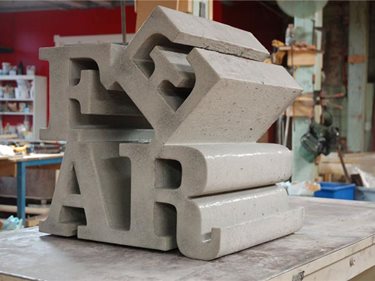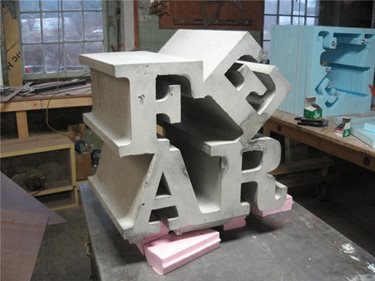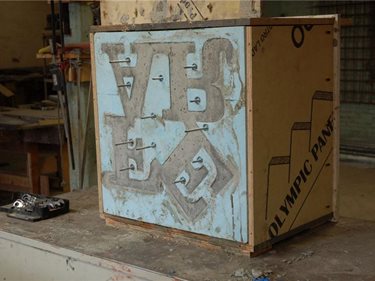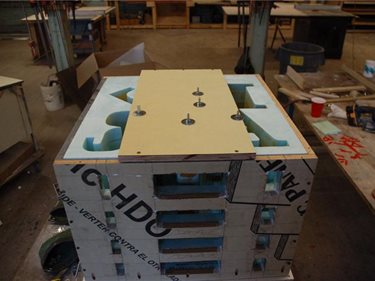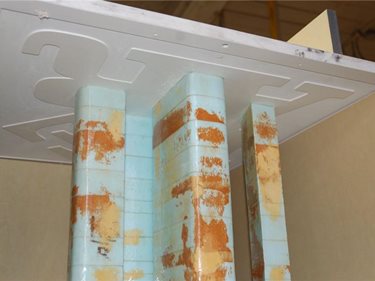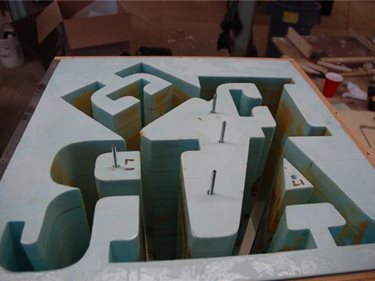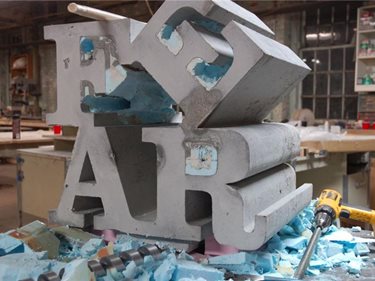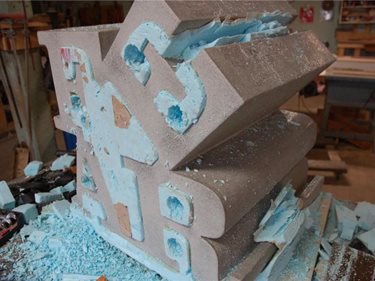- Staining Concrete
- Stamped Concrete
- Concrete Overlays
- Concrete Resurfacing
- Concrete Polishing
- Concrete Dyes
- Colored Concrete
- Indoor Concrete
- Concrete Floors
- Concrete Countertops
- Garage Floor Coatings
- Furniture, Sinks, Fire Bowls
- Basement Floors
- Outdoor Concrete
- Concrete Patios
- Concrete Driveways
- Concrete Pool Decks
- Outdoor Kitchens & Counters
- Outdoor Fireplace
- Concrete Walkways
- Concrete Pavers
- Concrete Walls
- Repair & Maintenance
- Foundation Repair
- Concrete Crack Repair
- Concrete Sealers
- Building with Concrete
- Concrete Homes
- Concrete Basements
- Decorative Concrete
- Fire Resistant
Concrete Art Sculpture Illustrates the State of Fear
Submitted by Stone Soup Concrete in Florence, MAModeled after the famous Robert Indiana 'love' sculpture, this typographical artistic sculpture is part of an exhibition examining the notion of fear, safety, and security after the events of 9/11. "They're art," says Mike Karmody of Stone Soup Concrete who was hired to build three of the sculptures. "The notion is using fear and concrete. Concrete is associated with enclosure and limitation," he says.
"It has the same typographical formation as the 'love' sculpture," explains Karmody. "But the 'love' sculpture shows the "o" leaning back in towards the lettering making it feel united and cohesive. In the 'fear' sculpture, the "e" bursts away. The "a" and the "r" are floating. The serifs are floating. Only the descender of the "r" hits the ground. It appears less stable looking."
Forming the Art Sculpture
The single piece casting measures 18" x 18" x 18" and weighs in at approximately 300 lbs. A CNC was used to create cutouts of the letters in negative form. "We built a foam form," says Karmody, "and it was epoxy jacketed to get a smooth surface."
One of the biggest challenges with the piece was taking into account that all five sides of the finished project would be visible. Each side had to look good. "You can see every side except for the bottom," explains Karmody. Pouring the piece required much planning to avoid inevitable air pockets and surface imperfections. "We poured the legible side down first, full to the top," says Karmody. "Then we put a back cap on it and inverted it. It holds in air pockets, so to reduce this, we had to pour from the back. But the back is visible as well, so we invert it. Pouring through the back eliminates 95-98% of air pockets so the front looks crisp."
Once it comes out of the form, Karmody says they don't repair or fill the surface. "It's very difficult to get in the nooks and crannies with hands," he says. The piece is left as is once the form is broken away.
On the underside of the piece, there is a recessed plinth which gives the floating effect to the letters. "The pieces that are plinths are much larger. They store extra concrete. When we invert it, any air pocket needs to be filled. The reservoirs provide the extra concrete." The only reinforcement in the piece is fiberglass added into the mix. Because of the unique forming structure, steel could not be added as reinforcement.
Karmody uses his own proprietary mix, but chooses LaFarge cement because the gray color is consistent. "The artists wanted the pieces to be a plain, regular concrete gray color. We used a densifier to finish it," says Karmody.
The artists, Adam Ames and Andrew Bordwin of Type A, had worked with Karmody before. They describe the inspiration behind the sculpture through the following:
"Bottom line is these pieces are a response to the political climate we've faced for seven years...Concrete is the perfect brutalist medium for this message. But it is oddly conflicted... after all, it is liquid and it can be very lyrical. So there's some tension there. The individuality of each is really important and if a sacrificial mold is what imparts that aspect, then so be it."
The first sculpture was exhibited in Chicago and Berlin this summer. The remaining two sculptures have been sold to private collectors.
Resources:
Stone Soup Concrete
Florence, MA
Read More About Concrete Statuary
Return to Concrete Statuary Projects
